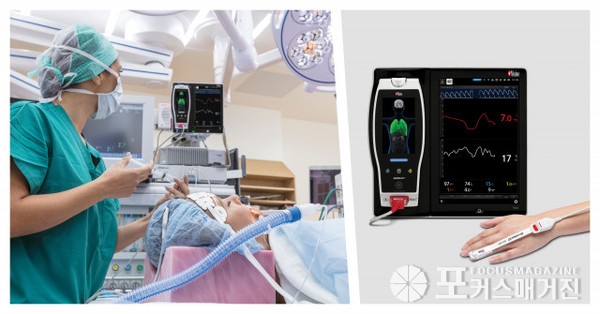 Masimo Root® with PVi® and SpHb® (Photo: Business Wire)
Masimo Root® with PVi® and SpHb® (Photo: Business Wire)NEUCHATEL, SWITZERLAND-Masimo (NASDAQ: MASI) today announced the findings of a prospective, randomized study published in Perioperative Medicine in which Dr. Yu Wang and colleagues at institutions in Shenzhen, Shaoguan, and Guangzhou, China evaluated the use of noninvasive, continuous Masimo PVi®, as part of goal-directed fluid therapy (GDFT), to guide intraoperative fluid administration during gastrointestinal (GI) surgery on elderly patients by comparing it to conventional fluid therapy. The researchers found that patients in the PVi group had a significantly lower rate of cardiopulmonary complications (8.4% vs 19.2%) and had a significantly lower total volume of fluid administered (median 2075 ml vs. 2500 ml).[1]
Noting the particular value of optimizing fluid management during GI procedures, especially in elderly patients, because of the high rate of postoperative complications and frequent fluid deficits (because of preoperative fasting, bowel preparation, and intraoperative fluid loss), the researchers sought to determine whether GDFT using Masimo PVi might improve outcomes in this challenging scenario. PVi, or pleth variability index, is a measure of the variations in perfusion index over the respiratory cycle, and has the advantage, compared to arterial line-based methods of gauging fluid responsiveness (e.g. stroke volume variation [SVV] and pulse pressure variation [PPV]), of being obtained via noninvasive Masimo rainbow SET® pulse oximetry and Pulse CO-Oximetry. PVi is indicated as a noninvasive, dynamic indicator of fluid responsiveness in select populations of mechanically ventilated adult patients. As the researchers note, PVi has been shown to perform similarly to invasive methods of fluid assessment, such as PPV and SVV, in a variety of surgeries.[2]
The researchers enrolled patients aged ≥ 65 years scheduled for elective GI surgery at two university hospitals between November 2017 and December 2020. Patients were randomly assigned to the GDFT group (n = 107) or the conventional fluid therapy (CFT) group (n = 104). In the GDFT group, fluid therapy was guided by PVi obtained from the photoplethysmographic waveform measured by fingertip rainbow® Pulse CO-Oximetry sensors. The outcomes evaluated and compared between the two groups were: composite complications at 30 days after surgery; cardiopulmonary complications at 30 days (pneumonia, atelectatis, pulmonary edema, arrhythmia, and acute myocardial infarction); time to first flatus; postoperative nausea and vomiting; infections including anastomotic leak rates; and postoperative length of hospital stay.
The researchers found that the rate of cardiopulmonary complications, as well as the total volume of fluid administered intraoperatively, were statistically significantly lower in the GDFT (PVi) group, as highlighted in the table below. Although there was a trend toward shorter length of stay and lower anastomotic leakage rates in the PVi group, these and other outcomes were not statistically significantly different.
(To view the table, please visit https://www.businesswire.com/news/home/20230820369137/en/)
The researchers concluded, “Among elderly patients undergoing GI surgery, intraoperative GDFT based on the simple and noninvasive PVi did not reduce the occurrence of composite postoperative complications but was associated with a lower cardiopulmonary complication rate than usual fluid management.”
Joe Kiani, Founder and CEO of Masimo, said, “We introduced PVi in 2007. It was the first and is still the only way of measuring fluid responsiveness noninvasively via pulse oximetry, with our pulse oximeters, at a fraction of the cost of invasive methods and without risk of invasive procedures to the patient. Since then, PVi has made a tremendous contribution to patient care, and its utility as a fluid responsiveness indicator has been shown in more than 100 independent, published studies.[2] This latest study adds to the outcomes evidence that PVi can be used to help clinicians manage the fluid levels of their patients without invasive catheters.”
In the U.S., PVi is FDA 510(k) cleared as a noninvasive dynamic indicator of fluid responsiveness in select populations of mechanically ventilated adult patients. Accuracy of PVi in predicting fluid responsiveness is variable and influenced by numerous patient, procedure and device related factors. PVi measures the variation in the plethysmography amplitude but does not provide measurements of stroke volume or cardiac output. Fluid management decisions should be based on a complete assessment of the patient’s condition and should not be based solely on PVi.
@Masimo | #Masimo
About Masimo
Masimo (NASDAQ: MASI) is a global medical technology company that develops and produces a wide array of industry-leading monitoring technologies, including innovative measurements, sensors, patient monitors, and automation and connectivity solutions. In addition, Masimo Consumer Audio is home to eight legendary audio brands, including Bowers & Wilkins, Denon, Marantz, and Polk Audio. Our mission is to improve life, improve patient outcomes, and reduce the cost of care. Masimo SET® Measure-through Motion and Low Perfusion™ pulse oximetry, introduced in 1995, has been shown in over 100 independent and objective studies to outperform other pulse oximetry technologies.[3] Masimo SET® has also been shown to help clinicians reduce severe retinopathy of prematurity in neonates,[4] improve CCHD screening in newborns[5] and, when used for continuous monitoring with Masimo Patient SafetyNet™ in post-surgical wards, reduce rapid response team activations, ICU transfers, and costs.[6-9] Masimo SET® is estimated to be used on more than 200 million patients in leading hospitals and other healthcare settings around the world,[10] and is the primary pulse oximetry at 9 of the top 10 hospitals as ranked in the 2022-23 U.S. News and World Report Best Hospitals Honor Roll.[11] In 2005, Masimo introduced rainbow® Pulse CO-Oximetry technology, allowing noninvasive and continuous monitoring of blood constituents that previously could only be measured invasively, including total hemoglobin (SpHb®), oxygen content (SpOC™), carboxyhemoglobin (SpCO®), methemoglobin (SpMet®), Pleth Variability Index (PVi®), RPVi™ (rainbow® PVi), and Oxygen Reserve Index (ORi™). In 2013, Masimo introduced the Root® Patient Monitoring and Connectivity Platform, built from the ground up to be as flexible and expandable as possible to facilitate the addition of other Masimo and third-party monitoring technologies; key Masimo additions include Next Generation SedLine® Brain Function Monitoring, O3® Regional Oximetry, and ISA™ Capnography with NomoLine® sampling lines. Masimo’s family of continuous and spot-check monitoring Pulse CO-Oximeters® includes devices designed for use in a variety of clinical and non-clinical scenarios, including tetherless, wearable technology, such as Radius-7®, Radius PPG®, and Radius VSM™, portable devices like Rad-67®, fingertip pulse oximeters like MightySat® Rx, and devices available for use both in the hospital and at home, such as Rad-97®. Masimo hospital and home automation and connectivity solutions are centered around the Masimo Hospital Automation™ platform, and include Iris® Gateway, iSirona™, Patient SafetyNet, Replica®, Halo ION®, UniView®, UniView :60™, and Masimo SafetyNet®. Its growing portfolio of health and wellness solutions includes Radius Tº®, Masimo W1™, and Masimo Stork™. Additional information about Masimo and its products may be found at www.masimo.com. Published clinical studies on Masimo products can be found at www.masimo.com/evidence/featured-studies/feature/.
ORi and RPVi have not received FDA 510(k) clearance and are not available for sale in the United States. The use of the trademark Patient SafetyNet is under license from University HealthSystem Consortium.
References
[1] Wang Y, Zhang Y, Zheng J, Dong X, Wu C, Guo Z, Wu, X. Intraoperative pleth variability index-based fluid management therapy and gastrointestinal surgical outcomes in elderly patients: a randomized controlled trial. Periop. Med. 2023. 12:16. DOI: 10.1186/s13741-023-00308-0.
[2] Published clinical studies on PVi can be found on our website at http://www.masimo.com.
[3] Published clinical studies on pulse oximetry and the benefits of Masimo SET® can be found on our website at http://www.masimo.com. Comparative studies include independent and objective studies which are comprised of abstracts presented at scientific meetings and peer-reviewed journal articles.
[4] Castillo A et al. Prevention of Retinopathy of Prematurity in Preterm Infants through Changes in Clinical Practice and SpO2 Technology. Acta Paediatr. 2011 Feb;100(2):188-92.
[5] de-Wahl Granelli A et al. Impact of pulse oximetry screening on the detection of duct dependent congenital heart disease: a Swedish prospective screening study in 39,821 newborns. BMJ. 2009;Jan 8;338.
[6] Taenzer A et al. Impact of pulse oximetry surveillance on rescue events and intensive care unit transfers: a before-and-after concurrence study. Anesthesiology. 2010:112(2):282-287.
[7] Taenzer A et al. Postoperative Monitoring - The Dartmouth Experience. Anesthesia Patient Safety Foundation Newsletter. Spring-Summer 2012.
[8] McGrath S et al. Surveillance Monitoring Management for General Care Units: Strategy, Design, and Implementation. The Joint Commission Journal on Quality and Patient Safety. 2016 Jul;42(7):293-302.
[9] McGrath S et al. Inpatient Respiratory Arrest Associated With Sedative and Analgesic Medications: Impact of Continuous Monitoring on Patient Mortality and Severe Morbidity. J Patient Saf. 2020 14 Mar. DOI: 10.1097/PTS.0000000000000696.
[10] Estimate: Masimo data on file.
[11] http://health.usnews.com/health-care/best-hospitals/articles/best-hospitals-honor-roll-and-overview.
Forward-Looking Statements
This press release includes forward-looking statements as defined in Section 27A of the Securities Act of 1933 and Section 21E of the Securities Exchange Act of 1934, in connection with the Private Securities Litigation Reform Act of 1995. These forward-looking statements include, among others, statements regarding the potential effectiveness of Masimo PVi®. These forward-looking statements are based on current expectations about future events affecting us and are subject to risks and uncertainties, all of which are difficult to predict and many of which are beyond our control and could cause our actual results to differ materially and adversely from those expressed in our forward-looking statements as a result of various risk factors, including, but not limited to: risks related to our assumptions regarding the repeatability of clinical results; risks related to our belief that Masimo‘s unique noninvasive measurement technologies, including Masimo PVi, contribute to positive clinical outcomes and patient safety; risks that the researchers’ conclusions and findings may be inaccurate; risks related to our belief that Masimo noninvasive medical breakthroughs provide cost-effective solutions and unique advantages; risks related to COVID-19; as well as other factors discussed in the “Risk Factors” section of our most recent reports filed with the Securities and Exchange Commission (“SEC”), which may be obtained for free at the SEC’s website at www.sec.gov. Although we believe that the expectations reflected in our forward-looking statements are reasonable, we do not know whether our expectations will prove correct. All forward-looking statements included in this press release are expressly qualified in their entirety by the foregoing cautionary statements. You are cautioned not to place undue reliance on these forward-looking statements, which speak only as of today's date. We do not undertake any obligation to update, amend or clarify these statements or the “Risk Factors” contained in our most recent reports filed with the SEC, whether as a result of new information, future events or otherwise, except as may be required under the applicable securities laws.
Website: http://www.masimo.com
<저작권자 © 포커스매거진 무단전재 및 재배포금지>

djp202
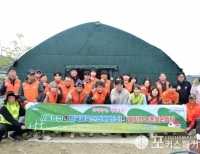 한국체육산업개발, 양주 버섯 농가 방문해 농촌봉사활동 펼쳐
서울한국체육산업개발주식회사(대표이사 신치용)는 25일, 경기도 양주시 광적면 일대 버섯 재배 농가를 방문해 ...
한국체육산업개발, 양주 버섯 농가 방문해 농촌봉사활동 펼쳐
서울한국체육산업개발주식회사(대표이사 신치용)는 25일, 경기도 양주시 광적면 일대 버섯 재배 농가를 방문해 ...
 아우로와 레알 마드리드, 전 세계 축구 팬들에게 혁신적 금융 상품 제공을 위해 파트너십 체결
오스틴, 텍사스 및 마드리드-글로벌 금융 서비스 및 기술 혁신 기업인 아우로(Ouro)와 레알 마드리드 축구 클럽(Real...
아우로와 레알 마드리드, 전 세계 축구 팬들에게 혁신적 금융 상품 제공을 위해 파트너십 체결
오스틴, 텍사스 및 마드리드-글로벌 금융 서비스 및 기술 혁신 기업인 아우로(Ouro)와 레알 마드리드 축구 클럽(Real...
 한국체육산업개발, 미사경정공원 도·농상생 활성화 농산물 직거래장터 성황리에 마무리
서울-한국체육산업개발(대표이사 신치용)은 지난 20~21일 양일간 하남시 소재 미사경정공원 운영동 광장에서 개최...
한국체육산업개발, 미사경정공원 도·농상생 활성화 농산물 직거래장터 성황리에 마무리
서울-한국체육산업개발(대표이사 신치용)은 지난 20~21일 양일간 하남시 소재 미사경정공원 운영동 광장에서 개최...
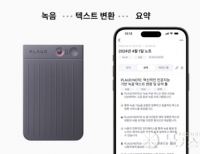 켄차커머스, ChatGPT 탑재 AI 녹음기 ‘플라우드 노트’ 한국 시장 론칭
서울-켄차커머스가 ChatGPT를 탑재한 AI 녹음기 ‘플라우드 노트(PLAUD NOTE)’를 국내 크라우드 펀딩 플...
켄차커머스, ChatGPT 탑재 AI 녹음기 ‘플라우드 노트’ 한국 시장 론칭
서울-켄차커머스가 ChatGPT를 탑재한 AI 녹음기 ‘플라우드 노트(PLAUD NOTE)’를 국내 크라우드 펀딩 플...
 서울연구원 ‘지속가능한 도시생태계, 서울’ 주제로 제2회 정책포럼 개최
서울-서울연구원(원장 오균)은 오는 4월 23일(화) 오후 3시 정동1928 아트센터 이벤트홀에서 ‘지속가능한 도...
서울연구원 ‘지속가능한 도시생태계, 서울’ 주제로 제2회 정책포럼 개최
서울-서울연구원(원장 오균)은 오는 4월 23일(화) 오후 3시 정동1928 아트센터 이벤트홀에서 ‘지속가능한 도...
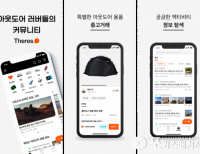 아웃도어 플랫폼 데얼스, 2024 스포츠산업 창업 도약 기업 선정
서울-아웃도어 커뮤니티·커머스 플랫폼 데얼스가 ‘2024년 스포츠산업 창업 도약 기업’으...
아웃도어 플랫폼 데얼스, 2024 스포츠산업 창업 도약 기업 선정
서울-아웃도어 커뮤니티·커머스 플랫폼 데얼스가 ‘2024년 스포츠산업 창업 도약 기업’으...
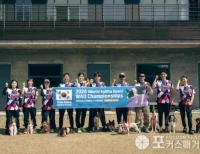 어질리티 국가대표팀, 강아지숲서 ‘2024 WAO 챔피언십’ 출정식
서울-도그 스포츠 분야 대규모 국제대회인 ‘2024 WAO (World Agility Open) 챔피언십’에 참가하는 대한민...
어질리티 국가대표팀, 강아지숲서 ‘2024 WAO 챔피언십’ 출정식
서울-도그 스포츠 분야 대규모 국제대회인 ‘2024 WAO (World Agility Open) 챔피언십’에 참가하는 대한민...
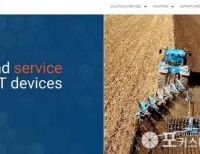 랜트로닉스, 수상 경력 보유한 텔레매틱스 게이트웨이 제품군 확장… 새로운 형태의 FOX4와 Bolero 43 엣지 컴퓨팅 …
어바인, 캘리포니아-컴퓨팅과 커넥티비티 사물인터넷(IoT) 솔루션 부문 글로벌 기업인 랜트로닉스(Lantronix Inc., 나...
랜트로닉스, 수상 경력 보유한 텔레매틱스 게이트웨이 제품군 확장… 새로운 형태의 FOX4와 Bolero 43 엣지 컴퓨팅 …
어바인, 캘리포니아-컴퓨팅과 커넥티비티 사물인터넷(IoT) 솔루션 부문 글로벌 기업인 랜트로닉스(Lantronix Inc., 나...
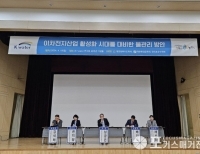 이차전지 산업의 지속 가능한 물관리 방안 민관협력 나서
대전-한국수자원공사(K-water, 사장 윤석대)는 4월 15일 대전 K-water연구원에서 이차전지 산업의 지속 가능한 수자원 ...
이차전지 산업의 지속 가능한 물관리 방안 민관협력 나서
대전-한국수자원공사(K-water, 사장 윤석대)는 4월 15일 대전 K-water연구원에서 이차전지 산업의 지속 가능한 수자원 ...
 프로젝트 에브리원, 부채 및 기후 위기 해결 위한 전례 없는 글로벌 금융 개혁 촉구 서한 발송
런던-국제통화기금(IMF)과 세계은행(WB)이 설립된 지 80년이 지난 현재 주요 배우들과 정치인, 아티스트, 이코노미...
프로젝트 에브리원, 부채 및 기후 위기 해결 위한 전례 없는 글로벌 금융 개혁 촉구 서한 발송
런던-국제통화기금(IMF)과 세계은행(WB)이 설립된 지 80년이 지난 현재 주요 배우들과 정치인, 아티스트, 이코노미...
 2024 ‘뽀꼬 아 뽀꼬’ 캠프 참가자 모집
서울-장애인먼저실천운동본부는 2024 ‘뽀꼬 아 뽀꼬’ 캠프 참가자를 4월 22일부터 5월 14일까지 모...
2024 ‘뽀꼬 아 뽀꼬’ 캠프 참가자 모집
서울-장애인먼저실천운동본부는 2024 ‘뽀꼬 아 뽀꼬’ 캠프 참가자를 4월 22일부터 5월 14일까지 모...
 미쉐린 가이드, 베트남 다낭으로 영역 확장
호치민, 베트남-미쉐린은 베트남 다낭을 ‘미쉐린 가이드(Michelin Guide)’의 미식 여행지에 새롭게 추...
미쉐린 가이드, 베트남 다낭으로 영역 확장
호치민, 베트남-미쉐린은 베트남 다낭을 ‘미쉐린 가이드(Michelin Guide)’의 미식 여행지에 새롭게 추...
 한국토지신탁 대행 ‘흑석11구역’ 철거 돌입… 1500세대 ‘서반포 써밋 더힐’ 재탄생 예고
서울-한국토지신탁이 사업대행자로 개발 추진 중인 흑석11재정비촉진구역 주택재개발정비사업(이하 흑석11구역 ...
한국토지신탁 대행 ‘흑석11구역’ 철거 돌입… 1500세대 ‘서반포 써밋 더힐’ 재탄생 예고
서울-한국토지신탁이 사업대행자로 개발 추진 중인 흑석11재정비촉진구역 주택재개발정비사업(이하 흑석11구역 ...
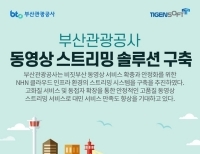 티젠소프트, 부산관광공사에 동영상 스트리밍 솔루션 구축
서울-멀티미디어 동영상 스트리밍 및 통합 메시지 전송 솔루션, 설문조사 솔루션 개발·판매 전문 기업 ...
티젠소프트, 부산관광공사에 동영상 스트리밍 솔루션 구축
서울-멀티미디어 동영상 스트리밍 및 통합 메시지 전송 솔루션, 설문조사 솔루션 개발·판매 전문 기업 ...
 영상 편집 콘텐츠 플랫폼 ‘곰믹스 마켓’, 차세대 인공지능 음원 서비스 출시
서울-동영상 소프트웨어 제작 전문 기업 곰앤컴퍼니(대표 이병기)는 동영상 편집 소스를 제공하는 플랫폼 &lsq...
영상 편집 콘텐츠 플랫폼 ‘곰믹스 마켓’, 차세대 인공지능 음원 서비스 출시
서울-동영상 소프트웨어 제작 전문 기업 곰앤컴퍼니(대표 이병기)는 동영상 편집 소스를 제공하는 플랫폼 &lsq...
 로블록스, 로블록스 크리에이터 펀드 업데이트 발표 및 새로운 브랜드 IP 협업 공개
캘리포니아-글로벌 몰입형 플랫폼 로블록스(Roblox)가 21일 로블록스에서 차세대 체험을 구축하고자 하는 크리에이...
로블록스, 로블록스 크리에이터 펀드 업데이트 발표 및 새로운 브랜드 IP 협업 공개
캘리포니아-글로벌 몰입형 플랫폼 로블록스(Roblox)가 21일 로블록스에서 차세대 체험을 구축하고자 하는 크리에이...
 삼성전자, 43형 모니터용 무빙 스탠드 출시
수원-삼성전자가 43형 모니터용 무빙 스탠드를 2일 출시했다.삼성전자는 기존 27형과 32형 모니터용에 이어 43형 �...
삼성전자, 43형 모니터용 무빙 스탠드 출시
수원-삼성전자가 43형 모니터용 무빙 스탠드를 2일 출시했다.삼성전자는 기존 27형과 32형 모니터용에 이어 43형 �...
 한국국제건설기계전, RAD KOREA 통합브랜드 구축·합동 개최
서울-산업통상자원부(장관 안덕근)가 주최하고 한국건설기계산업협회(회장 오승현)가 주관하는 ‘제12회 ...
한국국제건설기계전, RAD KOREA 통합브랜드 구축·합동 개최
서울-산업통상자원부(장관 안덕근)가 주최하고 한국건설기계산업협회(회장 오승현)가 주관하는 ‘제12회 ...
 네오팜, 일본 시장 성공 힘입어 세계 H&B 스토어 공략… 글로벌 영향력 넓힌다
대전-네오팜(대표 김양수)이 일본 뷰티 시장에서의 성과를 발판으로 전 브랜드의 해외 시장 진출에 박차를 가한...
네오팜, 일본 시장 성공 힘입어 세계 H&B 스토어 공략… 글로벌 영향력 넓힌다
대전-네오팜(대표 김양수)이 일본 뷰티 시장에서의 성과를 발판으로 전 브랜드의 해외 시장 진출에 박차를 가한...
 인피니언-HD한국조선해양, 선박 전동화 기술 협력
서울-인피니언 테크놀로지스(코리아 대표이사 이승수)와 HD한국조선해양이 에너지 효율적인 전력 반도체 기술을 ...
인피니언-HD한국조선해양, 선박 전동화 기술 협력
서울-인피니언 테크놀로지스(코리아 대표이사 이승수)와 HD한국조선해양이 에너지 효율적인 전력 반도체 기술을 ...